|
- Catalog (in stock)
- Back-Catalog
- Mail Order
- Online Order
- Sounds
- Instruments
- Projects
- History Face
- ten years 87-97
- Review Face
- our friends
- Albis Face
- Albis - Photos
- Albis Work
- Links
- Home
- Contact
- Profil YouTube
- Overton Network
P & C December 1998
- Face Music / Albi
- last update 03-2016
|
1. Höömijiin khelkee ayalguu - praising song for King Manduul - 5:16
2. Ikh ezen Bogd Chingiss khaan - praising song for King Genghis - 20:19
3. Dörvön Oirdiin uria - praising song for the tribe of the Oird - 9:15
4. Jargalant Altai magtaal - praising song of this mountain in the Mongolia Altai - 3:27
5. Setgemj - four mountains in Ulaanbaatar - höömij - 2:31
6. Höömijn törluud - höömij variation - 1:55
7. Elstiin gangad nutag - höömij from Western Mongolia - 3:16
8. Zakhchin-tatlaga - dance melody from Western Mongolia - 2:34
9. Gal Shargiin unaga - praising song of the Golf of Gal Sharga with the best horses - 6:38
10. Khan Bogd magtaal - praising song for all of our Khan Bogd - 11:35
The ensemble was founded in 1997. All its members have studied at the academy of music in Ulaanbaatar.
The Mongolians conferred the title Khan (Khan = King) to their highest-ranking ruler (tribal chief) of the tribes. Undur Gegeen Zanabazar was the first Bogd (1635-1723), this high-ranking Buddhist monk ruled from Urga, the historic capital of Mongolia. He was a celebrated monk and statesman, and he was also Mongolia's greatest artist. Since Zanabazar, this highest-ranking representative of the Buddhists in the 17th century, the title Khan Bogd (King Bogd) has been established. Khans were simultaneously highest-ranking Buddhist as well as profane leaders. The last Mongolian Khan Bogd died in 1924. He was the last religious and profane ruler of the Mongols who resided in the Khan Bogd Palace. The place of residence was called Ulaanbaatar, i.e. 'Red Warriors' or 'Red Heroes'.
In the Mongolian language this designation is also used for important or holy mountains or even whole mountain ranges, such as the Tavan Bogd Mountain Range in the Northern Mongolian part Khuvsgul aimark, the Aj Bogd-Mountain in the Western Mongolian area of the Gobi-Altai province, or the Bogd Khan Mountain Range near Ulaanbaatar, the oldest Mongolian nature reserve (today it is a national park).
In the Ensemble Khan Bogd these lamaistic gods, the secular rulers, and the mountains are being praised in praising songs (see this album: Magtaal - Höömij - FM 50044 - Vol. II). Some songs and texts are performed in throat singing (Höömij). In this first record 'Ayalguu' - FM 50043 - Vol. I there are performed short songs (bogin duu) and long songs (urtyin duu), with the female voice assuming an important role. The songs are about nature, man, animals (especially the horse) and the land of the Mongolian in general.
The Mongolian songs have a rich repertory. Music spread from home to home on the occasion of festivities and by way of teaching. The family or the clan meeting constituted a good chance to gather and sing together, the chance to learn from others, and to take home a new melody. In this way, the ancient patterns performed in various corners of Mongolia have been preserved by local masters for the whole nation. Some specific types are: labor songs (work songs); buuvei songs (lullaby); hunter's calls [to attract animals by imitating their call); various herder's calls, [to manage the herds by means of signalling (each animal has its own signal)]; uukhai or gulyingoon songs which are linked to seasonal events (arrival of spring, mare milk flows, horse race training, etc.); many other songs announcing birthdays, weddings, national holidays, winning a horse race or a wrestling competition, celebration of the elders, wool cutting, cashmere combing, arrival of harvest and many more songs for singing and dancing together.
The nomad shepherds in Mongolia, like other nomads from Central Asia, used to play string and wind instruments. The national music of Mongolia has had a rich background and a great tradition that goes back many centuries. Ensembles (orchesters) have performed at court or in the monasteries for lamaistic celebrations or in ritual ceremonies. Ensembles also play for daily rites in the ger (jurte - round tents). The morin khuur (horse-head violin or 'fiddle') (morin = horse; khuur = sound, rhyme, melody) is the most important traditional instrument for dance and to accompany songs. It is the national instrument.
People say that it is connected with a handsome man. It is also played when an ewe does not want to suckle its lamb. It is believed that the ewe, hearing this music, will feel better and accept its lamb.
There is a legend about the origin of this instrument. A Mongol missed his dead horse so much that he used its head, its bones and its hair to build an instrument on which he started to play the familiar noises of his beloved horse.
The history of this instrument is based on two other legends:
- A shepherd received as a gift from his beloved woman a magical horse that could fly. He used it at night to fly to meet his beloved. His jealous wife cut the horse's wings off, so that the horse fell from the sky and died. The grieving shepherd made a horse-head fiddle from his beloved horse.
- A boy named Sükhe (or Suho). After a wicked Lord (Pagan God) had slaughtered the boy's prized white horse, the horse's spirit came back to Sükhe in a dream and instructed him to make an instrument from the horse's body, so that the two could still be together and neither of them would have to be alone.
Songs
- Magtaal (praising songs)
Magtaal are sung in honour of the gods of Lamaism and the spirits of nature, heralds or in particular animals. Epic texts also contain praise songs for the mountains, the rivers, and nature in general. This is an ancient tradition still practised up to the present days by the tribes in the region of Mongol-Altai in Western Mongolia.
|
1. Höömijiin khelkee ayalguu - praising song for King Manduul |
|
- Orkhonbaatar Chinbat: ever buree, male voice, höömij, Gereltsogt Jamba: limbe, tsuur (frame drum), male voice, höömij, Ganburged Bukhchuluun: morin khuur, male voice, höömij, Dorjnyam Shinetsog-Gyeni: morin khuur, male voice, höömij, Ganbaatar Enkhzaya: yoochin, shigshuur (shaman rattle), Gankhuyag Uyanga: khuuchir, Gankhuyag Solongo: yatga |
|
- This melody is devoted to the Queen Mandukhai, the young wife of King Manduul, who reigned Mongolia from 1463 until 1467. After the king's death, she nominated a wise boy of the royal family as successor to the throne. She became his queen and ruled the kingdom in his name. |
|
|
|
2. Ikh ezen Bogd Chingiss khaan - praising song for King Genghis |
|
- Ganburged Bukhchuluun: morin khuur, male voice, text and höömij
- Orkhonbaatar Chinbat, Gereltsogt Jamba: male voice and höömij
- Dorjnyam Shinetsog-Gyeni: morin khuur, male voice, and höömij |
|
- During the 13th century, Genghis Khan ruled over the entire Central Asia, from China up to Eastern Europe. the legendary
Mongolian warrior and conqueror, however, has left more than terror and destruction in his life. He himself believed in shamanism, but he was also open for all other religions and supported all kinds of art. He promoted the old mongolian script (this mongolian-uighur letters "Uigarjin"). He was born in Burkhan Khaldun Uul (in the Khentii mountain range), and his childhood name was Temuzhin. His father Esuhei (means „hero“) from the Clan Borjigid was murdered (with poison) by the neighbouring clan of the tartars when he was nine years old. There were two important people in his life: his mother Oylen and his wife Börte (Burteljin goo). His famous horse was called "Er 2 Zagal“. |
|
|
|
3. Dörvön Oirdiin uria - praising song for the tribe of the Oird |
|
- Orkhonbaatar Chinbat, Gereltsogt Jamba: male voice and höömij
- Ganburged Bukhchuluun: morin khuur, male voice and höömij
- Dorjnyam Shinetsog-Gyeni: male voice, and höömi |
|
- This tribe has a lot of its very own tradition. They are very heroic people. Mongolian called them the "Blue Mongols“. At that time they had a darker skin. The Oirds (also spelled Oirat or Oyrat) are a branch of tribes inhabiting Western Mongolia. |
|
|
|
4. Jargalant Altai magtaal - praising song of this mountain in the Mongolia Altai |
|
- Gereltsogt Jamba: tovshuur, male voice and höömij |
|
|
|
9. Gal Shargiin unaga - praising song of Golf of Gal Sharga with the best horses |
|
- Duuren Uuriintuya: female voice (special voice "giingoo“)
- Dorjnyam Shinetsog-Gyeni: morin khuur, male voice and höömij |
|
- Golf of Gal Sharga with the best horses. Uuriintuya is singing about these fastest horses when they are ready for the race. Especially for these fast horses they sing in a voice called "giingoo“. |
|
|
|
10. Khan Bogd magtaal - praising song for all of our Khan Bogd (means kings and mountains) |
|
- Duuren Uuriintuya: female voice
- Natsag Gankhuyag: male voice (text of prayer), Orkhonbaatar Chinbat: ever buree, male voice (text of shaman), höömij, tsuur (shaman drum), shaman bells, shigshuur (shaman rattle), Gereltsogt Jamba: limbe, male voice, höömij, damar, denshig, Ganburged Bukhchuluun: morin khuur, male voice, höömij, Dorjnyam Shinetsog-Gyeni: morin khuur, male voice, höömij, Ganbaatar Enkhzaya: yoochin, female voice, Gankhuyag Uyanga: khuuchir, female voice, Gankhuyag Solongo: yatga, female voice |
|
- Praising all our King Bogd and our beautiful and great Khan Bogd mountains.
- Praising Mongolia our homeland with the Shamans, we call them "Div tenger boo“.
- Praising our religion and Buddhist ceremonial ritual.
In the late seventeenth and early eighteenth centuries, the sculptor par excellence among the Buddhist countries of Asia was our Undur Gegeen Zanabazar (1635-1723), the first Jebtsundamba Khutuktu, or Bogdo Gegeen (King Bogd), and the greatest sculptor of Mongolia. He was the founder of our art school "Zanabazar“. His artistic talent was already apparent when he was a young boy, when he was observed to be fond of drawing and building houses and temples with his little friends. He went to Tibet at the age of fourteen, where he was ordained by the Panchen Lama and proclaimed by the Fifth Dalai Lama as the Jebtsundamba Khutuktu. At that time the Potala Palace was being reconstructed, and Zanabazar must have come in contact with many fine art artists and craftsmen as they worked in Lhasa. When he returned to Mongolia in 1651, hundreds of Tibetian lamas and many artists and craftsmen, sent by the Fifth Dalai Lama to propagate the faith and to build new monasteries, accompanied him. |
- (guttural singing)
The performance of overtone singing usually takes place at social events such as eating or drinking parties.
The Mongols call their overtone singing höömij (= throat, pharynx). The singer creates a constant pitched fundamental considered as a drone, and at the same time modulates the selected overtones to create a formantic melody from harmonics.
Several techniques are known, depending on the vocal source and the place of resonance: kharkhiraa = lung, khamriin = nose, tövönkhiin = throat and bagalzuuriin = pharynx. Overtone singers form and vary sound and timbre with their mouth, teeth, tongue, throat, nose, and lips. They always form two distinct tones simultaneously sustaining the fundamental pitch.
Overtone singing can also be heard from Turkic-speaking tribes in disparate parts of Central Asia. The Bashkir musicians from the Ural Mountains call their style of overtone singing uzlyau; the Khakass call it khai, the Altai call it koomoi and the Tuvinians khoomei.
Up to date, overtone singing is a common feature of Siberian peoples as well as the Kazakhs and Mongolian tribes. Overtone or throat singing is a special technique in which a single vocalist simultaneously produces two distinct tones. One tone is a low, sustained fundamental pitch (a kind of drone), and the second is a series of flutelike harmonics, which resonate high above this drone. Who masters this singing technique may even make the overtone sound louder than the fundamental pitch, so the drone is not audible anymore. A different technique often used by overtone singers combines a normal glottal pitch with the low-frequency, pulse-like vibration known as vocal fry
|
5. Setgemj - four mountains - höömij |
|
- Orkhonbaatar Chinbat, Gereltsogt Jamba, Ganburged Bukhchuluun,
Dorjnyam Shinetsog-Gyeni: male voice and höömij |
|
- The city Ulaanbaatar is located between four mountains. This höömij praises these mountains and the nature around the capital. |
|
|
|
6. Höömijn törluud - different variation of höömij |
|
- Orkhonbaatar Chinbat, Gereltsogt Jamba, Ganburged Bukhchuluun, Dorjnyam Shinetsog-Gyeni: male voice, höömij |
|
- This piece consists of several höömij variations in the kharkhiraa (lung) technique (grumbling, croaking höömij used especially for epic songs because of the magnificent and pathetic melody) and the isgaree technique (a kind of whistling höömij) with the khamryn (= nose; the sound passes only through the nose) höömij. |
|
|
|
7. Elstiin gangad nutag - land of Elstiin Gangad in the Gobi - höömij from Western Mongolia |
|
- Duuren Uuriintuya: female voice
- Dorjnyam Shinetsog-Gyeni: morin khuur, male voice |
|
- In Western Mongolia there are located the highest mountains, and the Gobi desert has its beginning. There are many Yaks in the great nature with the mountains and the sand inbetween. The region of Elstiin Gangad is homeland for the Yakspeople. |
|
|
|
9. Zakhchin-tatlaga - dance melody from Western Mongolia |
|
- Ganburged Bukhchuluun: morin khuur, Dorjnyam Shinetsog-Gyeni: morin khuur |
|
- When the Zakhchin and the tribes of Western Mongolia dance their folk dances ("bij" - "bielgee"), they mainly move the upper part of the body. With their movements they express their identity and gender as well as their tribal and ethnic affiliation. Besides the gender-specific movements, there are others that imitate typical activities of their everyday life, such as the nomadic herdsmen's life, the daily work in the fields or the historical events of their tribe. This kind of dance is mainly performed during celebrations inside the ger (jurte - round tents), during festivals of the local nobility or during ceremonies in the monasteries. Every tribe has its particular forms of expression. |

Gankhuyag Natsag
director
|
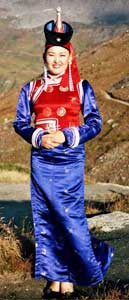
Duuren Uuriintuya
female voice
|

Dorjnyam Shinetsog-Gyeni and Ganburged Bukhchuluun
morin khuur
|
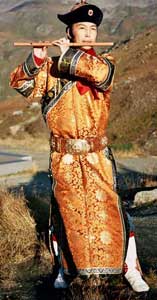
|
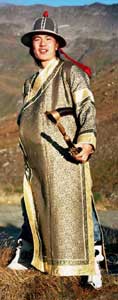
Orkhonbaatar Chinbat
ever buree
|
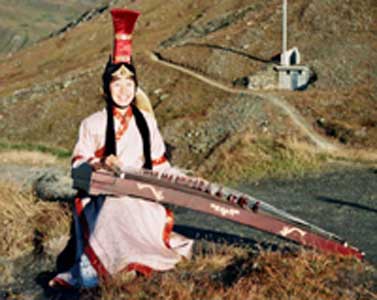
|

Ganbaatar Enkhzaya
yoochin
|

Gankhuyag Uyanga
khuuchir
|
|
Instruments
- Limbe (wind instrument)
The instrument is frequently used in accompaniment, occasionally also as a solo instrument. In former times it was made of bamboo or wood, nowadays mostly of plastic, particularly those imported from China. These flutes (transverse flutes) are closely bound up with the nomads of Central Asia.
The length of this instrument is approx. 64 cm, with nine holes, whereof one is the blowhole and two others are reserved for the tuning. It is often played with circular breathing*. The sound reflects what is heard in the nature or the sounds of the natural and social environment.
- *Circular breathing (bituu amisgal): one note is blown while the musician inhales through his nose. The air is collected inside the cheeks and exhaled by the pressure of the cheeks' muscles (same principle as for the bagpipe). The base of the tongue is used as a valve.
- Surnai - ever buree (wind instrument)
Reed instrument - a folk oboe with a conical body made of wood or horn (ever buree = horn), widening towards the end. It has seven finger holes and one thumbhole. A metal staple carries the reed and a lip-disc in the shape of a funnel. The short form of the instrument is known as "haidi", meaning 'flute of the sea'.
- Khuuchir (string instrument)
Formerly, the nomads (called "the savages") mainly used the snake skin violin or horsetail violin. The Chinese call it "the Mongol instrument" or "Huk'in". It is tuned in the interval of a fifth and is small or middle sized.
The khuuchir has a small, cylindrical, square or cup-like resonator made of bamboo, wood or copper, covered with a snake skin and open at the bottom. The neck is inserted in the body of the instrument. It usually has four silk strings, of which the first and the third are accorded in unison, whereas the second and fourth are tuned in the upper fifth. The bow is coated with horsetail hair and inseparably interlaced with the string-pairs; in Chinese this is called "sihu", that is "four", also meaning, "having four ears". The smaller instruments have only two strings and are called "erh'hu", that is "two" in Chinese.
- Khun tovshuur - Tovshuur (string instrument)
The khun tovshuur is a two-stringed instrument similar to the lutes of Tuva, Altai or Kazakhstan. The body and the neck are carved from cedar wood and the body is often coated with the leather of wild animals, camels or goats. The strings are plaited with horsetail hair and tuned in the interval of a fourth.
The West Mongols use this lute to accompany the "tuuli" (heroic-epic myths) and the "magtaal" (praise songs).
- Morin khuur (string instrument - horse-head-violin)
The morin khuur is a typical Mongolian two-stringed instrument. The body and the neck are carved from wood. The end of the neck has the form of a horse-head and the sound is similar to that of a violin or a cello. The strings are made of dried deer or mountain sheep sinews. It is played with a bow made of willow, stringed with horsetail hair and coated with larch or cedar wood resin.
This instrument is used to play polyphonic melodies, because with one stroke of the bow the melody and drone-strings can be played at the same time. The morin khuur is the most widespread instrument in Mongolia, and it is played during celebrations, rituals and many other occasions, as well as an accompaniment for dances or songs. Even the sound and noises of a horse herd are imitated on the morin khuur.
- Yoochin (string instrument)
Box zither - dulcimer with 13 double-wire strings. The strings are struck with two wooden sticks, so-called little wooden hammers (comparable with the santur of the Persians). It has a black wooden soundboard richly decorated with ornaments.
The instrument was only familiar to townspeople and first of all only they played it.
- Yatga (string instrument)
The yatga is a half-tube zither with a movable bridge. It is constructed as a box with a convex surface and an end bent towards the ground. The strings are plucked and the sound is very smooth. The instrument was considered to be sacrosanct and playing it was a rite, bound to taboos. The instrument was mainly used at court and in monasteries, since strings symbolised the twelve levels of the palace hierarchy.
Shepherds were forbidden to play the twelve-stringed zither, but they were allowed to play the ten-stringed zither, which was also used for interludes during recitations of epics.
Mongolians traditionally play three types of this zither, differentiated by their resonators or hollow bodies in which the sound is amplified. Designs include the master yatga; ikh gariing yatga, the national yatga; akhun ikh yatga, and the harp, called the bosoo yatga.
- Tuur - frame drum -shaman drum (percussion instrument)
Is a single-headed shaman drum. Its frame is usually oval but sometimes round. The membrane is ornamented with drawings on one ore both sides.
- Shigshuur - shaman rattle (percussion instrument)
The Mongolian Shamans also use a type of rattle called the Shigshuur. It is made from a cow horn, with the pointed end being carved into the shape of a raven's head. The Shigshuur is used to direct and send energy in a specific direction, the rattle being shaken like a raven pecking.
- Denshig – small bells (percussion instrument)
They are only used in the Mongolian region. These are two plainished brass plates, the grips (knobs) of which are connected by means of a small band. On the occasion of services, a lama bangs the two little plates together, thereby producing a sound similar to the touch of a small bell but significantly softer and more melodic.
- Damar (percussion instrument)
Small drums used in monasteries, a wooden casing with resemblance to a coil. On both outer surfaces it is coated with leather. In the middle of the coil there is a band made from silk with emobroidery and two buttons attached to a string. By moving back and forth, these two buttons are hit on the stretched leather of this small drum.
- Shaman bells (percussion instruments)
The bells are made of brass, or iron. They are fixed up on the cloth. These bells are mostly signal bells which shamans used in a dance to awaken the gods.
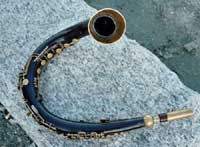 |
Surnai - ever burre = horn (wind instrument) |
 |
Khuuchir (string instrument) |
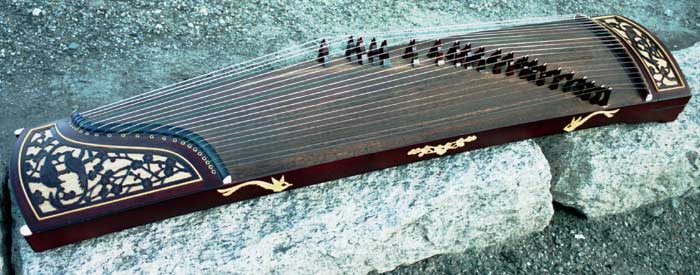 |
Yatga (string instrument)
- master yatga with 21 strings (ikh gariing yatga) |

|
Tuur - frame drum - shaman drum (percussion instrument) |
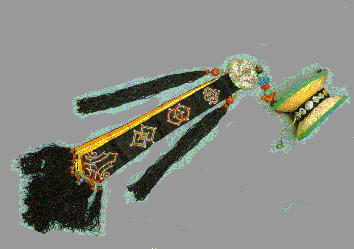 |
Damar (percussion instrument) |
Revised by Hermelinde Steiner
PageTop

|
